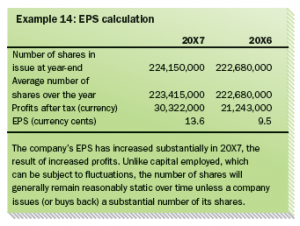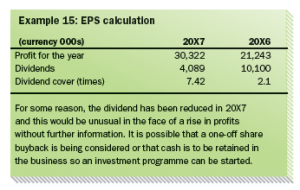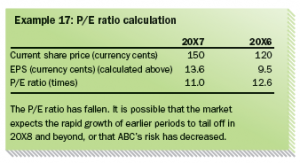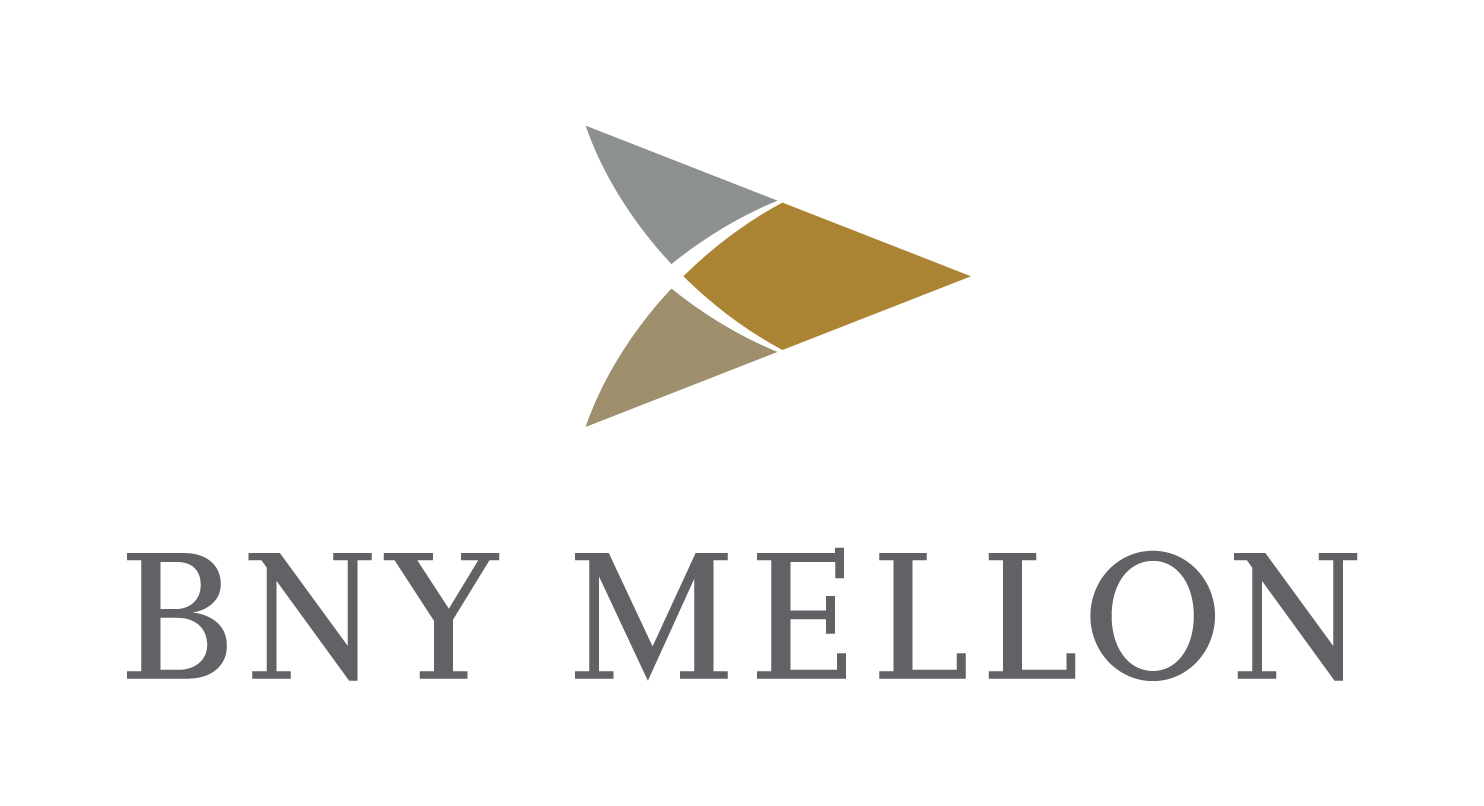The second and final part of the WILL SPINNEY feature on ratio analsis
The first part of this feature covered such key ratios as return on capital employed, operating profit margin and return on equity, as well as a variety of liquidity and solvency performance measures. This time around, we’re looking at the gearing/ leverage ratio and interest cover, as well as a range of shareholder measures such as earnings per share.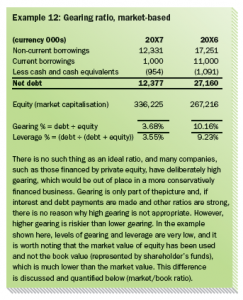
GEARING/LEVERAGE
Gearing: debt ÷ equity or Leverage: debt ÷ (debt + equity)
Gearing and leverage measure how much of the company is financed by debt and represent very quick ways of assessing the credit risk of business. They are in common usage. Clearly some businesses can withstand higher ratios than others and so the ratio has to be taken in context with other factors.
The first formula listed above measures debt as a percentage of equity and is usually referred to as “gearing”. The second formula takes debt as a proportion of the total external financing of the company (provided by shareholders and debt-holders); it is usually referred to as “leverage” and equals the proportion of the assets financed by debt.
When calculating these ratios the equity value may be taken as the book value or the market value. When the ratios are used for financial decisionmaking purposes (such as project evaluation) it is usual to take market values for both debt and equity when calculating these ratios. Thus, in this context, equity means market capitalisation rather than the shareholders’ funds reported in the balance sheet. However, when used in start-up situations such as leveraged buyouts and when monitoring compliance with financial covenants1 it is always the accounting (book) values of debt and equity that are used. This is because the ratio would be very volatile if market data was used and a fall in the share price alone could cause a default, which no treasurer would want.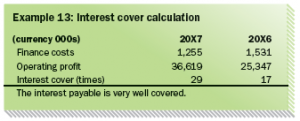
Companies usually benefit from some debt in their capital structure (subject to availability and cost, for example, in the credit crunch). Debt is cheaper than equity (funds from shareholders) because it is less risky from the point of view of the lender, who, therefore, accepts a lower rate of return. Lenders may have some kind of security over the assets (so they can take control of and if need be sell them to repay borrowings), and, even if not, rank above shareholders in the order of payment if the company collapses. Also, the interest on debt is tax-deductible. On the other hand, a company does not want too much debt, as the interest and capital repayments have to be made whatever the cash position of the company, and too much debt creates fi nancial risk.
Earnings (profit) before interest and tax (EBIT) ÷ interest charge Earnings (profit) before interest, tax depreciation and amortisation (EBITDA) ÷ interest charge
This shows how easily a company was able to make its interest payments from the year’s profits. An interest cover of three means that interest payments could have been three times higher and the company would still have been able to meet interest payments (assuming profit is not too far away from cashflow).
The lowest acceptable figure is clearly a matter of judgement, not least as a view has to be taken about the volatility of profits, and also levels of interest rates. A ratio of less than two, however, is likely to raise the risk of difficulties for nearly all businesses, although some highly leveraged structures start off with an even lower cover. In the case of our model business ABC, we will assume that the whole of “finance costs” is interest2.
SHAREHOLDER MEASURES
Earnings per share (EPS) Profit attributable to ordinary shareholders ÷ weighted average number of shares in issue during the year
The earnings per share measure represents the profi t aft er tax divided by the weighted average number of ordinary shares in issue during the year, and so eff ectively shows the net profi t the company made on each share during the year. It is the change in EPS that is important and which can be compared with the change for other companies; the absolute fi gure is not helpful on its own.
Profi t attributable to ordinary shareholders ÷ dividends
Th is indicates the extent to which dividends are covered by profits. Some companies will pay out little or nothing as dividends whereas others might pay out all their profi ts for the year. The dividend cover is important because it shows whether the company struggled to pay the dividend or did so without diffi culty, and thus acts as a guide to the likelihood of a maintained or improved level of dividend in the future.
Dividend yield
Dividend per share ÷ current share price
An actual or potential investor in a company will want to know what return on their investment they will receive. Th e dividend yield gives them part of this information (the other factor they are interested in is the movement in the share price).
Price to earnings ratio (P/E, PER)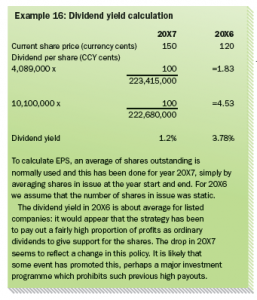
Current share price ÷ earnings per share
A high P/E ratio (relative to the stock market average) indicates market expectations of relatively rapid growth in earnings from the company or that the company is considered lower risk.
Market/book ratio
Market value of the company’s equity ÷ total equity
This compares the company’s market capitalisation (the share price multiplied by the number of shares) with the book value of its equity, as shown by the value of total equity on the balance sheet. The ratio should be treated with caution because the balance sheet is a combination of assets and liabilities, some valued at cost or realisable value (for example, inventory and receivables) and some at market value (for example, investment property and derivative instruments).
A market/book ratio greater than one indicates that stock market investors consider there is more value in the company than just the book value of its net assets. Th is additional value might consist of factors such as expectations of future profi tability and a highly skilled workforce.
Simply performing a ratio analysis on a company does not provide a great deal of meaningful information in itself. The ratios calculated must be evaluated and compared with the ratios of other relevant companies and over time – choices which depend on the purpose of the exercise.
The key to the intelligent use of ratios is to shift the focus away from individual ratios towards a more consistent, interpretative picture of the company and to allow for trade-offs of one ratio against another. It is not usually possible to draw conclusions based on a single ratio, especially as there are no reliable rules about the appropriate ratio levels. For example:
- a drop in sales may well be compensated by better margins on those sales;
- high balance sheet gearing may be of no great concern because of excellent corporate profitability over a number of years; or
- a year of poor profitability may be redeemed by the generation of cash from tight control of working capital.
Remember that all ratios can be affected by accounting manipulation and subtleties in presentation.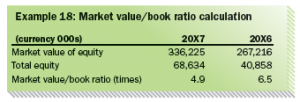
A final point on ratio analysis is that there is a need to identify the reasons for changes. For instance, why are profit margins declining? Why is gearing increasing? Why have sales increased so much? Why are sales to fixed assets so low? Understanding the answers to such questions should address the most significant financial or nonfinancial issues about a company.
First publi shed in the Cash Management Supplement to the Treasurer, the official publication of the Association of Corporate Treasurers, www.treasurers.org , 2010
Will Spinney is ACT technical officer for education. wspinney@treasurers.org
1 Loan documents commonly include performance measures known as financial covenants.
2 Under international finance reporting standards (IFRS), finance costs may include items such as amortisation of upfront fees
 Cash And Trade Magazine For Cash and Trade professionals in the Middle East
Cash And Trade Magazine For Cash and Trade professionals in the Middle East

